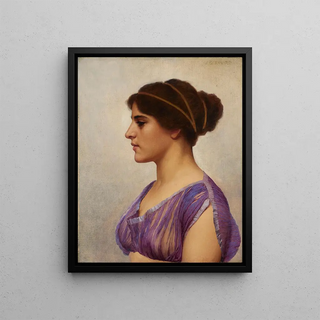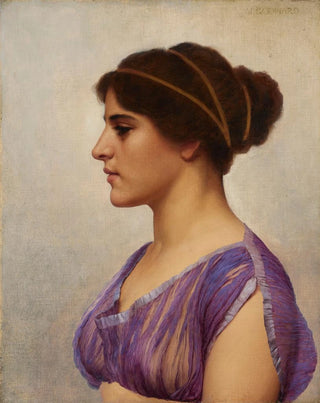Art print | Study of a classical beauty - John William Godward


View from behind

Frame (optional)
In the world of art, certain works transcend their era to become timeless symbols of beauty and elegance. "Study of a Classical Beauty - John William Godward" is a perfect example. This piece, imbued with rare delicacy, transports us into a universe where feminine beauty is both celebrated and idealized. Godward, with his mastery of colors and shapes, manages to capture the very essence of classical beauty, a theme that spans ages and continues to inspire contemporary artists. By contemplating this work, the viewer is invited to immerse themselves in a silent dialogue with beauty, to explore the nuances of classical aesthetics, and to feel the harmony emanating from every detail.
Style and uniqueness of the work
Godward's work stands out for its unique style that merges neo-classicism and pre-Raphaelitism. "Study of a Classical Beauty" perfectly illustrates this approach, where the precision of the lines blends with a palette of soft, luminous colors. The female figure, central to the composition, is depicted with remarkable finesse, each fold of her garment and each reflection of light on her skin carefully crafted. The background, often adorned with floral motifs or idealized landscapes, creates a setting conducive to the blossoming of beauty. Godward manages to establish an atmosphere of serenity and contemplation, inviting the viewer to linger on the details and appreciate the delicacy of the scene. This work is not merely a visual representation but a true hymn to timeless beauty, where each element contributes to a captivating visual harmony.
The artist and his influence
John William Godward, a British artist of the early 20th century, is often considered one of the last representatives of the classical tradition in art. His work, although sometimes overshadowed by his contemporaries, deserves special attention for its ability to merge ancient influences with the artistic concerns of his time. Godward, trained at the Royal Academy, draws inspiration from Renaissance masters and neo-classicism, while incorporating a sensitivity

Matte finish

View from behind

Frame (optional)
In the world of art, certain works transcend their era to become timeless symbols of beauty and elegance. "Study of a Classical Beauty - John William Godward" is a perfect example. This piece, imbued with rare delicacy, transports us into a universe where feminine beauty is both celebrated and idealized. Godward, with his mastery of colors and shapes, manages to capture the very essence of classical beauty, a theme that spans ages and continues to inspire contemporary artists. By contemplating this work, the viewer is invited to immerse themselves in a silent dialogue with beauty, to explore the nuances of classical aesthetics, and to feel the harmony emanating from every detail.
Style and uniqueness of the work
Godward's work stands out for its unique style that merges neo-classicism and pre-Raphaelitism. "Study of a Classical Beauty" perfectly illustrates this approach, where the precision of the lines blends with a palette of soft, luminous colors. The female figure, central to the composition, is depicted with remarkable finesse, each fold of her garment and each reflection of light on her skin carefully crafted. The background, often adorned with floral motifs or idealized landscapes, creates a setting conducive to the blossoming of beauty. Godward manages to establish an atmosphere of serenity and contemplation, inviting the viewer to linger on the details and appreciate the delicacy of the scene. This work is not merely a visual representation but a true hymn to timeless beauty, where each element contributes to a captivating visual harmony.
The artist and his influence
John William Godward, a British artist of the early 20th century, is often considered one of the last representatives of the classical tradition in art. His work, although sometimes overshadowed by his contemporaries, deserves special attention for its ability to merge ancient influences with the artistic concerns of his time. Godward, trained at the Royal Academy, draws inspiration from Renaissance masters and neo-classicism, while incorporating a sensitivity






